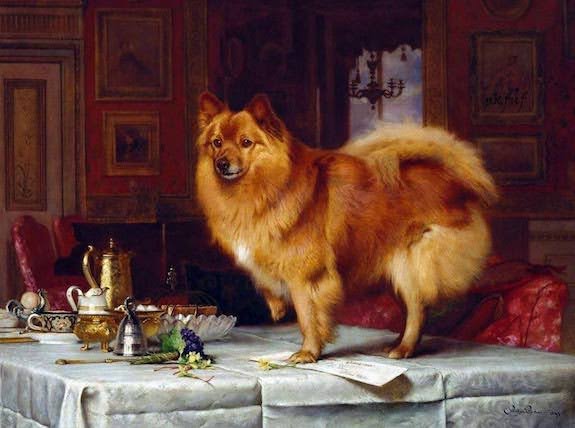
The difficulty in evaluating a coated breed is obvious, and thus, hands on such a dog will “see” better than the naked eye.
Ascertaining the soundness of, say, a Pomeranian’s hindquarters is challenged by the dog’s “pants,” or heavy feathering on the back of the legs. In this breed, the legs should stand wide enough to provide a base of support for the body; The stifles should have a moderate bend, which is to say not too much and not too little because either extreme will not only thwart balance in the front assembly, but cause the added problem of compensating for a lack of balance. The hocks should be straight and parallel, and short to allow the Pom the endurance to trot for a period of time before tiring out.
At this point, you might be wondering why this is important in a lap dog. Note to reader: We are of the opinion that soundness is important in all our breeds, but one should remember, too, that the Pomeranian is descended from larger Spitz breeds that pulled sleds, hunted, and herded. Breeding the Pomeranian bred down in size wasn’t a license to breed away from structural soundness because whatever its size, a well balanced, structurally sound Pomeranian was – and is – pleasing to the eye.
When England’s Kennel Club was formed in 1873, the spitz dog was among the first breeds recognized, and the first Poms being exhibited weighed nearly 18 pounds. It was Queen Victoria’s fondness for smaller versions of the breeds that would lead a trend to smaller Poms. The Queen’s large and influential breeding kennel continued to reduce the breed’s size even as Victoria continued to import small Pomeranians from across Europe, including one of her favorite dogs, “Windsor’s Marco” from Florence, Italy. When Marco was first exhibited in 1891, the 12 pound red coated dog created a stir and popularized small Poms (as well as the red color).
By the end of Victoria’s life, the average size of the Pomeranian had decreased by at least 50%, but her legacy in the breed wasn’t just a reduction in size, it was an adherence to maintaining the breed’s structural soundness that is still preferred today.
Image: “Marco on the Queen’s Breakfast Table” painted by Charles Burton Barber in 1893
